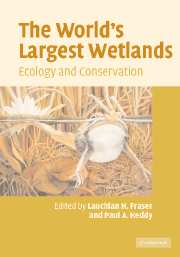Book contents
- Frontmatter
- Contents
- List of contributors
- Preface
- 1 Introduction: big is beautiful
- 2 The West Siberian Lowland
- 3 The Amazon River basin
- 4 The Hudson Bay Lowland
- 5 The Congo River basin
- 6 The Mackenzie River basin
- 7 The Pantanal
- 8 The Mississippi River alluvial plain
- 9 The Lake Chad basin
- 10 The River Nile basin
- 11 The prairie potholes of North America
- 12 The Magellanic moorland
- 13 The future of large wetlands: a global perspective
- Index
- References
2 - The West Siberian Lowland
Published online by Cambridge University Press: 10 August 2009
- Frontmatter
- Contents
- List of contributors
- Preface
- 1 Introduction: big is beautiful
- 2 The West Siberian Lowland
- 3 The Amazon River basin
- 4 The Hudson Bay Lowland
- 5 The Congo River basin
- 6 The Mackenzie River basin
- 7 The Pantanal
- 8 The Mississippi River alluvial plain
- 9 The Lake Chad basin
- 10 The River Nile basin
- 11 The prairie potholes of North America
- 12 The Magellanic moorland
- 13 The future of large wetlands: a global perspective
- Index
- References
Summary
Introduction
The West Siberian Lowland is a geographical region of Russia bordered by the Urals in the west and the Yenisey River in the east, the Kara Sea of the Arctic Ocean in the north and the Kazakh steppes in the south (Fig. 2.1). The region covers 2 745 000 km2 stretching from 62–89°E to 53–73 °N. The length from west to east is more than 2000 km and from south to north more than 2500 km. It is about seven times the size of Germany, five times the size of France, and approximately equal to the size of Argentina.
The Lowland represents 16% of the territory of Russia; it is the lowest and flattest part of the country and is tilted slightly towards the north. It is confined to Hercynian and West Siberian epiplatforms, which were regularly submerged by polar seas in its geological past. The relief of the Lowland is very flat, and is composed of quaternary sand, loam, and clay deposits. Altitudes range between 0 and 300 m above sea level with an average of 100 m. The climate is continental with winters lasting five to seven months. Mean monthly temperatures vary through a range of 40°C, changing from +5°C to +16°C in July and from −20°C to −25°C in January. Annual precipitation varies from 390 to 600 mm. Permafrost covers one-third of the northern part of the region.
- Type
- Chapter
- Information
- The World's Largest WetlandsEcology and Conservation, pp. 11 - 62Publisher: Cambridge University PressPrint publication year: 2005
References
- 3
- Cited by



